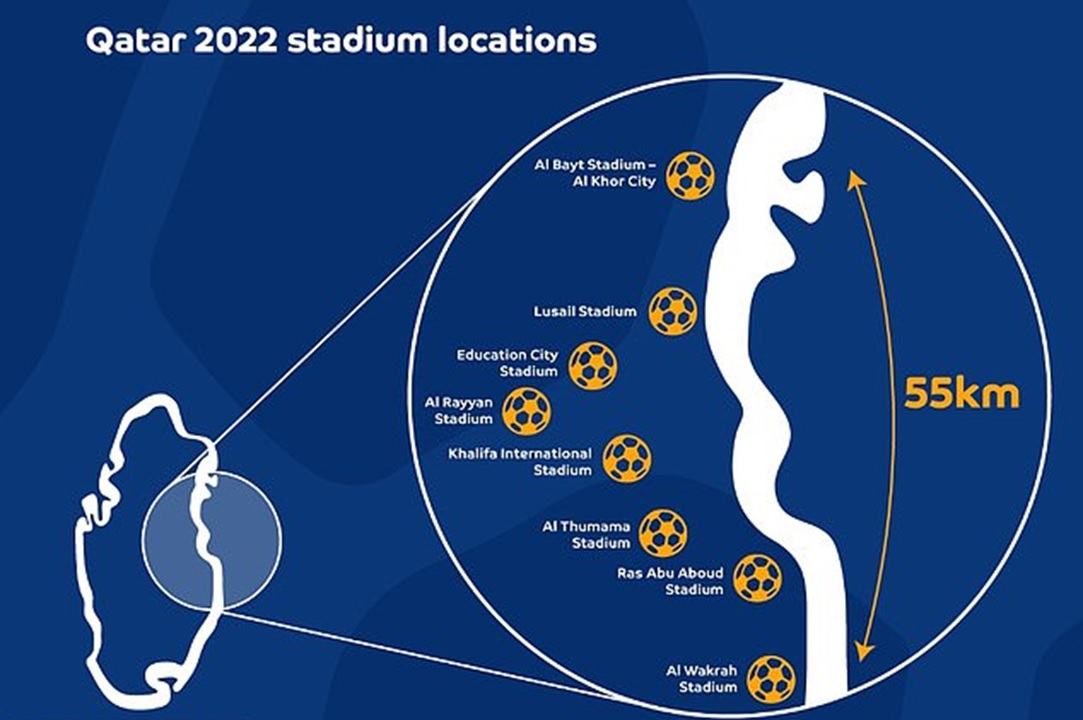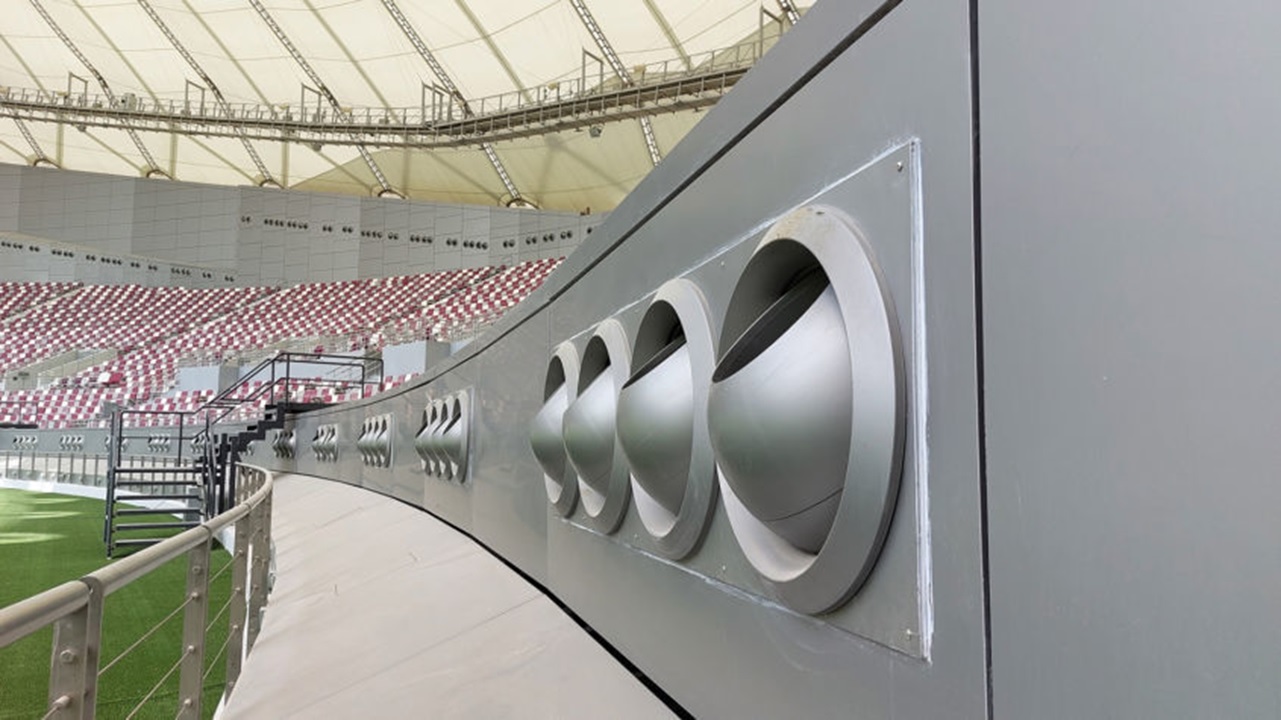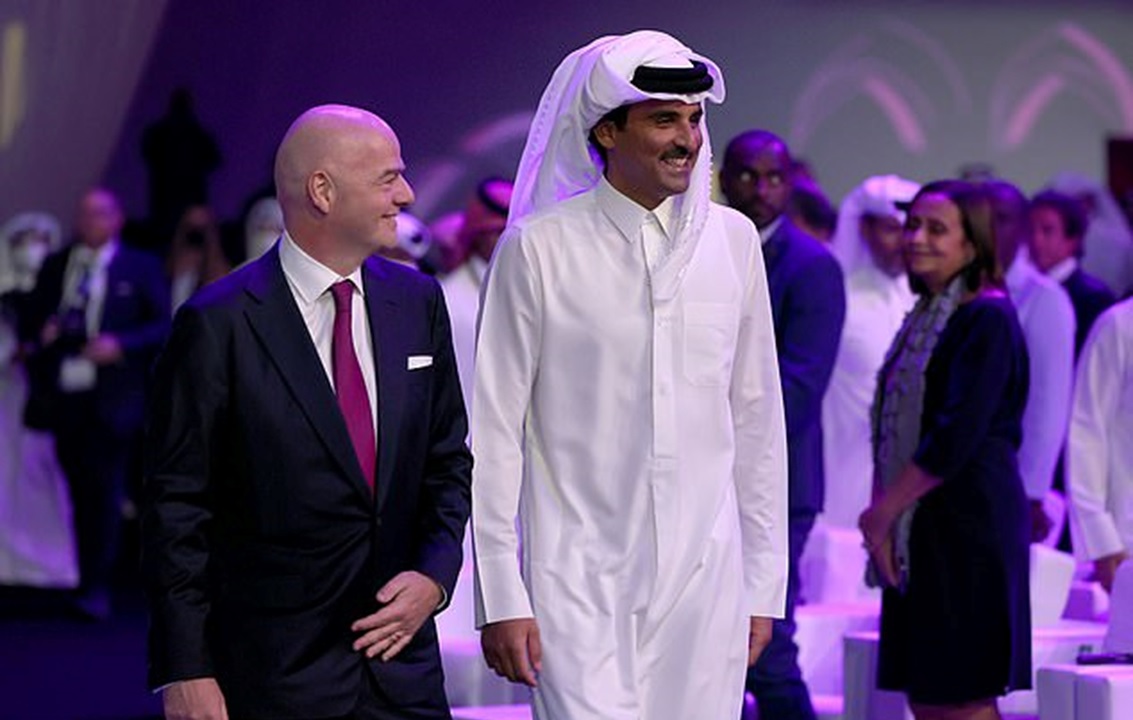FIFA’s claims of carbon neutrality being rejected as “Misleading”
The eight stadiums built in Qatar for the 2022 World Cup would virtually fit inside Greater London’s boundaries. The modest distances between stadiums at the Qatar World Cup appear to provide an environmental advantage over earlier competitions because they eliminate the requirement for air travel after the first whistle sounds on November 21. …
The eight stadiums built in Qatar for the 2022 World Cup would virtually fit inside Greater London’s boundaries.
The modest distances between stadiums at the Qatar World Cup appear to provide an environmental advantage over earlier competitions because they eliminate the requirement for air travel after the first whistle sounds on November 21.
However, a damning new analysis has sparked doubts about FIFA and Qatar’s promise to host the first-ever carbon-neutral World Cup.
In Russia 2018, the host towns of Saint Petersburg in the north and Krasnodar in the south were more than 1,000 miles apart, forcing teams, support staff, and spectators to fly across the nation, emitting carbon dioxide as they did so.
Qatar FIFA World Cup 2022 venues only separated by 55km or 34 miles

This season, the largest as the crow flies separating two stadiums in the desert state is 34 miles, while the smallest is only four miles.
Additionally, a brand-new Metro system connects five stadiums, and a fleet of specially designed electric buses will transport spectators to the remaining three. Teams can choose a base and stay there throughout the game.
The greatest distance that spectators or teams will have to travel this time is actually the equivalent of Hatfield to Sevenoaks from north to south and Kingston-upon-Thames to Greenwich from east to west, according to a map of the recently constructed stadiums in Qatar superimposed onto south-east England.
FIFA and the Qatari authorities have attempted to highlight the World Cup’s environmental credentials, in part due to the competition’s condensed nature, despite the fact that the decision to award it to Qatar has been highly contentious and given rise to persistent allegations of human rights violations during the construction of stadiums and infrastructure.
For the first time, FIFA claims it is dedicated to staging a truly carbon-neutral World Cup.
However, despite the minimal travel necessary to view the matches, environmental activists have again cautioned regarding the competition’s environmental impact.
The tournament’s organisers, the Qatar Supreme Committee and FIFA, have been charged with misleading’ fans by stating the event will be carbon-neutral in a damning report.
With six months until the first game, a devastating analysis from the environmental advocacy group Carbon Market Watch, which has worked with the European Union and other international organisations to measure carbon emissions, has called into question FIFA’s assertions.
It would be wonderful to see the FIFA World Cup’s negative impact on the environment significantly minimised. However, the claim of carbon neutrality is untrue, according to Gilles Dufrasne of Carbon Market Watch, who wrote the research.
The report stated that despite a lack of transparency, the evidence suggests that the emissions from this World Cup will be significantly higher than the organisers had anticipated. The carbon credits being bought to offset these emission levels are unlikely to have a sufficient effect on the climate.
According to FIFA, the World Cup will generate more carbon dioxide than 71 nations combined and more than the 2.1 million tonnes created in Russia in 2018.
Some of Qatar’s benefits from having stadiums so close together may be lost as fan organisations worry that not all travelling fans will be able to locate lodging.
Only 130,000 hotel rooms are expected to accommodate the more than one million anticipated visitors in the Middle Eastern nation.
Fans would have to fly in for matches at a significant financial and environmental expense. Therefore neighbouring nations are already prepared to host them.
CMW worries about how Qatar and FIFA measure and offset carbon emissions

The stadiums, primarily constructed from scratch in the desert, have come under special fire for their design and reuse.
Eight stadiums—seven of which are brand-new—will host the 32-nation competition, and the eighth, the Khalifa Stadium, has undergone a massive renovation in preparation for the World Cup, which gets underway on November 21.
CMW claims that this has significantly impacted carbon emissions, but the competition’s organisers only account for a small percentage of it in their calculations.
According to CMW, to determine the fraction of the total emissions related to the building of these facilities attributed to the World Cup, the number of days of the competition was divided by the expected lifetime of the stadiums.
Therefore, the body determines FIFA’s claims of carbon neutrality are “far-fetched.”
The stadiums were built expressly for the World Cup, and Doha, the capital of Qatar, only had one significant stadium before hosting the event, according to CMW.
The paper claims that it is questionable how many stadiums in such a limited area will be used in the future.
Qatar is a tiny nation. With a population of only 2.9 million, more than 2.5 million are foreign workers, and the country is roughly half the size of Wales in terms of area.
In terms of football, the nation backs the Qatar Stars League, a top-tier league with 12 teams. Only 1,500 people watch the most popular side, Al-Sadd, also known as The Boss, at home on average in Doha.
According to the website FootballCritic, their opponent Al-Rayyan received 708 fans on average in 2020, which is the next-highest attendance.
So, even after they have been scaled down after the tournament, the desire for the beautiful game in Qatar does not seem to sustain a legacy of football stadiums with a combined capacity of more than 150,000.
Additionally, according to CMW, the method used to offset carbon emissions is “questionable.”
According to the report, a new standard was devised expressly for the event, raising concerns about the independence and legitimacy of this certification method.
It is improbable that the projects that are now registered will produce credits to fully offset the emissions from the competition, and the World Cup will not be “carbon-neutral with such subpar credits.”
Plans to establish trees and grass in the desert are also disregarded as “not credible.”
Following the competition, the Qatari government has stated that some stadiums will be smaller, while six venues with 20,000–45,000 capacity will remain.
The Khalifa Stadium, which will be the largest, will have 170,000 fewer seats than the other five combined.
Stadium 974, made of shipping containers, will be fully disassembled, while the flagship, Lusail Stadium, will be decommissioned and turned into a centre for community and educational services.
According to the organisers’ website, Qatar’s idea is to provide demountable grandstand seats to nations in need of athletic facilities, thereby assisting the building of a solid legacy of football growth.
The Supreme Committee is confident that this plan will guarantee that Qatar will have usable stadiums after 2022. We do not intend to use any so-called “white elephants.”
The World Cup’s claims of being carbon-neutral and its efforts to reduce and offset emissions have been vigorously contested by the Supreme Committee and FIFA, according to CMW.
A Supreme Committee for Delivery & Legacy representative told Sportsmail that drawing inferences about the SC’s promise to deliver the first carbon-neutral FIFA World Cup was speculative and wrong.
According to the course, hosting a carbon-neutral World Cup will be conducted. Internal flights won’t be necessary because all matches will be held in and around Doha, thanks to the modern Doha Metro, which will serve as the main transportation hub and be backed up by approximately 800 brand-new electric buses.
For many years to come, the newly built 10-kilometre-long, 800-megawatt solar power facility will supply sustainable energy. Additionally, roughly a million square metres of fresh green space will be used for enjoyment, to lower local temperatures, and to cut emissions.
The statement continued that the unavoidable emissions during tournament preparation and hosting will be offset through investments in globally recognised and certified carbon credits. Instead of criticising the SC, we should applaud its decision to offset carbon emissions openly and proactively responsibly.
FIFA claimed to Sportsmail that it “has never misled its stakeholders.”

According to a spokesperson, FIFA is fully aware of mega-event risks to the economy, natural environment, individuals, and society. It has been trying to address those impacts and use possibilities to minimise the adverse effects and maximise the positive influences of its iconic event.
Stadium-building includes thorough legacy plans and economic models pre-and post-event, according to the world football governing body. Therefore it is reasonable for the organisers to allocate emissions from construction to the period they are used for the World Cup.
The spokesperson continued, “The organisers have committed to measuring, mitigating, and offsetting all FIFA World Cup 2022 greenhouse gas emissions while pushing low-carbon solutions in Qatar and the region.”
Qatar 2022 emphasises its efforts to lower carbon emissions, which include “sustainable design and construction” of stadiums, use of renewable energy, planting 500,000m2 of turf, as well as nearly 700,000 mostly drought-resistant shrubs and trees in-stadium precincts and public spaces, all of which are watered with recycled water.






